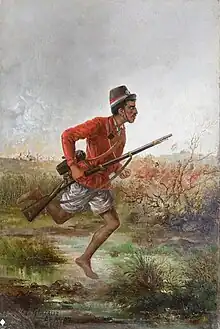| Battle of Acosta Ñu | |||||||
|---|---|---|---|---|---|---|---|
| Part of the Paraguayan War | |||||||
 Battle of Campo Grande, by Pedro Américo. | |||||||
| |||||||
| Belligerents | |||||||
| Commanders and leaders | |||||||
|
|
| ||||||
| Strength | |||||||
|
3,646 12 cannons[1]: 103 |
1st and 2nd Corps[1]: 103 more than 20,000 Brazilian and Argentine soldiers | ||||||
| Casualties and losses | |||||||
|
3,500:[2][1]: 104 2,000 killed 1,500 wounded and captured |
602:[1]: 104 182 killed 420 wounded | ||||||
The Battle of Acosta Ñu or Campo Grande (Guarani: Acosta Ñu ñorainõ) was a battle during the Paraguayan War, fought on 16 August 1869, between the Triple Alliance and Paraguay. The 3,500 poorly armed Paraguayans, mostly boys between nine and 15 years old, old men and wounded combatants, confronted 20,000 Brazilian and Argentine veteran soldiers.[3][1]: 104
Background
In the middle of 1869, the Paraguayan Army was on full retreat and Asunción was under allied occupation. Francisco Solano López, the Paraguayan president, refused to surrender and retreated to the hills, vowing to keep fighting to the end. The commander of the allied forces, Luís Alves de Lima e Silva, the Duke of Caxias, suggested that the war was militarily over. Pedro II, the Brazilian emperor, refused to stop the campaign until López surrendered. Caxias then resigned and was replaced by the Emperor's son-in-law, prince Gaston of Orleans, the Count of Eu.
The Count of Eu and the main Allied troops advanced and took Caacupé on August 15, though López had already moved to Caraguatay. In an attempt to block the Paraguayan Army from retreating to Caraguatay, the Count of Eu sent the 2nd Corps via Barrero Grande, while the 1st Corps pursued López.[1]: 103
Battle

The Allied troops met the rearguard of the Paraguayan forces at Acosta Ñu on August 16. The battle started at 0800. Acosta Ñu (which means "Acosta's Field", "Acosta" being a popular last name) is a vast plain of roughly 12 km2 (4.6 sq mi), ideal for the Brazilian cavalry. The initial charge was led by the Allied 1st Corps infantry, supported by artillery. As the Paraguayans retreated across the Yagari River, the 4th Cavalry Brigade made a right flanking movement. Meanwhile, the 2nd Corps reached the Paraguayan rear, which left them no means to retreat. Children were said to cling to the legs of Brazilian soldiers amidst the raging battle, pleading for mercy, only to be decapitated without hesitation. Once all flanks collapsed, the wounded children tried to flee the battlefield alongside their relatives. Yet the Brazilian commander ordered his cavalry to cut the retreat and set the battlefield ablaze, including the field hospital. Large numbers of children died because of these actions.[1]: 104 [4]
Legacy
The battle of Acosta Ñu is depicted in the famous painting Batalha de Campo Grande by Pedro Américo, and in the book Recordações de Guerra e de Viagem by famous Brazilian writer Alfredo d'Escragnolle Taunay, who took part in the battle.
In Paraguay, Children's Day is celebrated on August 16. It is a national holiday to commemorate the memory of the children who lost their lives in the battle.
References
- 1 2 3 4 5 6 7 Hooker, T.D., 2008, The Paraguayan War, Nottingham: Foundry Books, ISBN 1901543153
- ↑ Gabriele Esposito (2015). Armies of the War of the Triple Alliance 1864–70: Paraguay, Brazil, Uruguay & Argentina. Osprey Publishing. p. 19. ISBN 978-1-4728-0725-0.
- ↑ Chiavenato, José Julio (2011) Genocidio Americano. La Guerra del Paraguay ISBN 978-9000039562
- ↑ Rosa, José María (1964) "La Guerra del Paraguay y las Montoneras argentinas" A. Peña Lillo, Editor, Buenos Aires